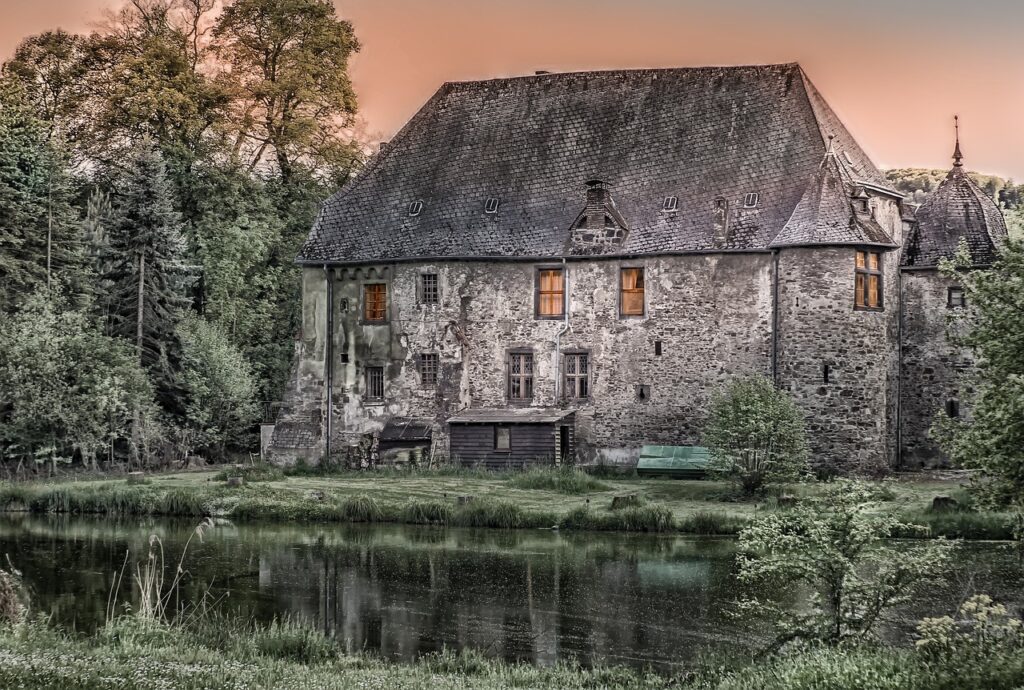In the realm of home maintenance, one of the most alarming concerns is the possibility of roof collapse caused by a leak. As a homeowner, you may have wondered about the potential risks and the necessary steps you can take to prevent such a catastrophic scenario. This article aims to provide a comprehensive overview of the measures you can implement to safeguard your property and loved ones from the devastating consequences of a roof collapse stemming from a leak. With an understanding of early warning signs, regular inspections, and prompt repairs, you can mitigate the risks and ensure the structural integrity of your roof remains intact.

This image is property of pixabay.com.
Signs of a Roof Leak
Water stains on the ceiling
One of the most common signs of a roof leak is the presence of water stains on the ceiling. These stains may appear as discolored patches or water rings, and they are often an indication that water is entering your home through the roof. If you notice any water stains on your ceiling, it is important to address the issue promptly to prevent further damage.
Dripping or pooling water
Another clear indication of a roof leak is the presence of dripping or pooling water. If you notice water dripping from your ceiling during or after rainfall, it is a strong sign that there is a leak in your roof. Similarly, if you see pools of water accumulating on your floor or furniture, there is likely a leak that needs to be addressed immediately.
Mold or mildew growth
Mold and mildew thrive in moist environments, making them a telltale sign of a roof leak. If you notice any mold or mildew growth on your walls or ceilings, particularly in areas near the roof, it is a strong indication of a leak. Mold and mildew can not only damage your home’s structure but also pose health risks, so it is crucial to address the underlying issue as soon as possible.
Rust or corrosion on metal fixtures
If you observe any rust or corrosion on metal fixtures in your attic or near your roof, it could be a sign of water infiltration caused by a roof leak. Metal fixtures such as nails, flashing, or vents that are exposed to moisture over a prolonged period are susceptible to rusting or corroding. Regularly inspect these fixtures for any signs of damage to catch and fix leaks before they cause extensive harm.
Causes of Roof Leaks
Damaged or missing shingles
Damage to shingles is one of the primary causes of roof leaks. Over time, shingles can become cracked, broken, or start to deteriorate due to age, severe weather, or improper installation. When shingles are damaged or go missing, it creates openings that allow water to seep into your roof and home. Regularly inspecting your roof for any damaged or missing shingles and promptly repairing or replacing them is crucial in preventing leaks.
Clogged gutters
Clogged gutters can contribute to roof leaks by allowing water to back up and overflow onto the roof. When leaves, debris, or other materials obstruct the flow of water through the gutters, it can lead to water pooling on the roof’s surface. This excess water can seep into the roof, causing leaks and potential damage. Regular maintenance, including cleaning out your gutters and ensuring proper drainage, can help prevent leaks caused by clogged gutters.
Cracked flashing
Flashing is the material used to create a watertight seal between the roof and other structures, such as chimneys, skylights, or vent pipes. When flashing becomes cracked or damaged, it compromises the seal and allows water to penetrate the roof. Regularly inspecting the flashing around these structures and promptly repairing or replacing any damaged flashing is essential in preventing leaks.
Improperly sealed vents or skylights
Vents and skylights are vulnerable areas on a roof, as they require proper sealing to prevent water from entering. If vents or skylights are not adequately sealed or if the seals deteriorate over time, they can become points of entry for water. Regularly checking the seals around vents and skylights and resealing them when necessary is crucial in preventing leaks caused by improper sealing.
Ice dams
In colder climates, ice dams can be a significant cause of roof leaks. Ice dams form when snow or ice accumulates on the roof and melts, only to refreeze at the edges or in the gutters. This ice buildup prevents the proper drainage of water and can force water underneath the roof’s shingles, leading to leaks. Removing excessive snow from the roof and addressing insulation and ventilation issues in the attic can help prevent ice dams and subsequent leaks.
Punctures or holes in the roofing material
Punctures or holes in the roofing material, whether caused by falling debris, animal activity, or improper installation, can create pathways for water to enter your home. Regularly inspect your roof for any signs of punctures or holes and promptly repair them to prevent leaks. It is important to address these issues promptly, as even small openings can lead to significant water damage over time.
The Dangers of Roof Leaks
Structural damage
One of the most significant dangers of roof leaks is the potential for structural damage to your home. Water infiltration through the roof can weaken the structural components, such as the wooden beams or trusses supporting the roof. Over time, this can lead to sagging ceilings, buckling walls, or even roof collapse in severe cases. Promptly addressing roof leaks is essential in preserving the structural integrity of your home.
Mold and mildew growth
Roof leaks provide the perfect environment for mold and mildew to flourish. Moisture from leaks can seep into walls, insulation, and other porous materials, creating an ideal breeding ground for mold spores. Mold growth not only damages your home’s structure but also poses health risks for you and your family. Exposure to mold can lead to respiratory issues, allergies, and other health complications. Preventing and promptly repairing roof leaks is crucial in preventing mold and mildew growth.
Electrical hazards
When water infiltrates your home through a roof leak, it can come into contact with electrical wiring, outlets, or appliances. This poses a significant electrical hazard, as water is an excellent conductor of electricity. Roof leaks can increase the risk of electrical shorts, power outages, or even electrical fires. It is essential to address roof leaks promptly to mitigate the potential electrical hazards they pose.
Fire hazards
Roof leaks can also increase the risk of fire hazards in your home. When water comes into contact with electrical components, such as faulty wiring or overloaded circuits, it can lead to short circuits or electrical malfunctions. These electrical issues can, in turn, cause sparks, which can ignite flammable materials in your home and start a fire. Regularly inspecting your roof, addressing leaks, and ensuring proper electrical safety measures are in place can help minimize the risk of fire.
Preventive Measures for Roof Leaks
Regular roof inspections
Routine roof inspections are essential in identifying potential leaks before they cause significant damage. Hiring a professional roofing contractor to inspect your roof at least once a year can help detect any issues early on and prevent leaks. Additionally, inspections should be conducted after severe weather events, such as storms or high winds, to assess any potential damage.
Maintaining gutters and downspouts
Proper gutter and downspout maintenance is crucial in preventing roof leaks. Regularly cleaning out debris, such as leaves or twigs, from your gutters and ensuring that downspouts are clear and directing water away from your home can prevent water backup and subsequent leaks.
Repairing damaged shingles
Inspecting your roof for damaged or missing shingles is an important preventive measure against leaks. Promptly repairing or replacing any damaged shingles can help maintain the integrity of your roof and prevent water infiltration.
Sealing roof penetrations
Ensuring that roof penetrations, such as vent pipes or chimneys, are properly sealed is crucial in preventing leaks. Regularly checking the seals and promptly resealing any areas of concern can help maintain a watertight roof.
Insulating and ventilating the attic
Proper insulation and ventilation in the attic play a vital role in preventing roof leaks. Adequate insulation helps regulate temperature and prevent ice dams, while proper ventilation removes excess moisture and prevents condensation, reducing the risk of leaks.
Removing ice dams
In colder climates, taking proactive measures to remove ice dams can help prevent roof leaks. Removing excessive snow from the roof and using roof rakes or heat cables can prevent the buildup of ice that can lead to leaks. Additionally, addressing insulation and ventilation issues in the attic can minimize the formation of ice dams.

This image is property of pixabay.com.
Shingle Maintenance and Replacement
Checking for damaged or missing shingles
Regularly inspect your roof for any damaged or missing shingles. Look for signs such as cracks, breaks, or curling edges. These damaged shingles can compromise the integrity of your roof and lead to leaks. Promptly address any issues by repairing or replacing the damaged shingles.
Replacing broken or deteriorated shingles
If you come across any broken or deteriorated shingles during your inspection, it is important to replace them promptly. Broken shingles can allow water to seep into your roof and cause leaks. By replacing these damaged shingles, you can maintain the integrity of your roof and prevent leaks.
Addressing curled or lifted shingles
Curled or lifted shingles can also be a potential source of roof leaks. These shingles create gaps or openings that can allow water to penetrate your roof. If you notice any curled or lifted shingles during your inspection, carefully flatten them or secure them back in place. If needed, consider replacing these shingles to ensure a watertight roof.
Gutter Maintenance
Removing debris from gutters
Regularly clean out your gutters to remove any debris, such as leaves, twigs, or dirt. Debris accumulation can obstruct water flow, leading to water backup and potential leaks. Make sure to wear gloves and use a ladder or safety equipment when performing gutter maintenance.
Checking for leaks or damage
While cleaning your gutters, inspect them for any signs of leaks or damage. Look for cracks, holes, or separation between gutter segments. Promptly repair or replace any damaged sections to maintain proper gutter function and prevent leaks.
Ensuring proper downspout placement
Check that your downspouts are properly positioned to direct water away from your home’s foundation. Ensure that the downspouts extend at least five feet from the house to prevent water from pooling near the foundation. Proper downspout placement helps prevent water from backing up onto the roof and causing leaks.

This image is property of pixabay.com.
Flashing Inspection and Repair
Examining flashing for cracks or gaps
Regularly inspect the flashing around chimneys, vent pipes, skylights, and other penetrations for any cracks or gaps. Flashing provides a waterproof barrier and prevents water from entering your home. If you notice any issues with the flashing, such as deterioration or damage, promptly repair or replace it to maintain a watertight seal.
Repairing or replacing damaged flashing
If you identify damaged flashing during your inspection, it is important to address it promptly. Damaged flashing compromises the integrity of the seal, making it easier for water to penetrate your roof. By repairing or replacing the damaged flashing, you can prevent leaks and protect your home from water damage.
Vents and Skylights
Checking for proper sealing
Regularly check the seals around vents and skylights to ensure they are properly sealed. Over time, seals can deteriorate due to weather exposure or age, potentially leading to leaks. If you notice any signs of inadequate sealing, reseal the areas promptly to prevent water infiltration.
Repairing or replacing damaged vents or skylights
If you notice any damage to vents or skylights during your inspection, address it promptly. Damaged vents or skylights can be a significant source of roof leaks. Repair or replace any damaged components to maintain a watertight roof.
Attic Insulation and Ventilation
Installing sufficient insulation
A properly insulated attic helps regulate temperature and prevent ice dams, reducing the risk of roof leaks. Ensure that you have sufficient insulation in your attic to maintain a consistent climate and prevent heat loss. Insulation also helps prevent condensation, minimizing the risk of leaks caused by excess moisture.
Ensuring proper attic ventilation
Proper ventilation in the attic is vital in preventing roof leaks. Ventilation helps remove excess moisture from the attic, reducing the risk of condensation and mold growth. Ensure that your attic has proper ventilation, including intake and exhaust vents, to maintain a healthy and dry environment.
Dealing with Ice Dams
Removing excessive snow from the roof
To prevent ice dams and subsequent roof leaks, it is important to remove excessive snow from your roof. Using a roof rake or hiring a professional snow removal service can help prevent the buildup of snow that contributes to ice dam formation.
Using roof rakes or heat cables to prevent ice buildup
Roof rakes and heat cables can be effective tools in preventing ice buildup on your roof. Roof rakes allow you to remove snow from the ground level, preventing it from melting and forming ice dams. Heat cables can be installed on your roof’s edges or in the gutters to melt ice and facilitate proper water drainage.
Addressing insulation and ventilation issues in the attic
To prevent ice dams, it is important to address insulation and ventilation issues in your attic. Insufficient insulation or inadequate ventilation can contribute to ice dam formation. By ensuring proper insulation and ventilation, you can reduce the risk of ice dams and subsequent roof leaks.
By being aware of the signs of roof leaks, understanding their causes, and implementing preventive measures, you can protect your home from the dangers and damages associated with roof leaks. Regular maintenance, inspections, and prompt repairs are key to maintaining a watertight roof and preserving the integrity of your home. Remember to consult a professional roofing contractor for any complex repairs or if you are unsure about the condition of your roof. By taking proactive measures, you can ensure a safe and leak-free home.
